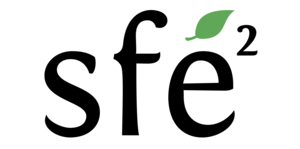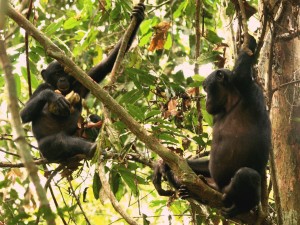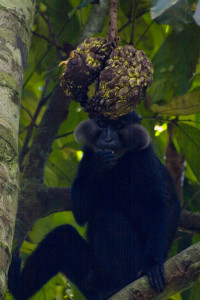Les risques écologiques de la défaunation en forêt tropicale du Congo
David Beaune
Laboratoire Biogéosciences UMR CNRS 6282 Université de Bourgogne 6 blvd Gabriel, 21000 DIJON France
Max-Planck-Institute for Evolutionary Anthropology Dept. Primatology Deutscher Platz 6 D – 04103 LEIPZIG Germany
david.beaune (at) gmail.com
Résumé
L’étude des singes des marais (Allenopithecus nigroviridis) qui était le projet initial, s’est vite heurtée aux problèmes de conflits hommes/primates. Les conflits s’intensifient avec les hommes qui colonisent de plus en plus les bords de rivière et dont ils doivent partager l’habitat. Les singes des marais sont les seuls animaux à s’attaquer aux stocks de maniocs qui reposent dans les étangs pour le processus de dissolution du cyanure. Au cours de cette mission de terrain, la pression de chasse quotidienne sur les groupes d’Allenopithecus n’a pas permis d’observations sereines et valables. Chaque matin des groupes d’hommes armés traquait comme nous les singes, mais pour les abattre. Les ‘Kelo’ sont à la fois peste et gibier .
Très vite, face à ces problèmes, l’objectif s’est tourné vers l’importance des animaux dans la dispersion de graines dans ce contexte de défaunation et de forêts touchés par le syndrome des forêts vide. L’inventaire des stratégies de dispersion de graines parmi les plantes de LuiKotale (Parc national de la Salonga, RDCongo) et l’inventaire botanique de 12ha de forêt a permis d’estimer que plus de 85% dépendent des animaux pour leur dispersion de graines soit près de 95% des arbres de la forêt. Certaines espèces dépendent totalement des singes pour la levée de dormance tégumentaire et l’activation de la germination. Plus d’une quarantaine de vertébrés ont été identifiés comme disperseurs de graine, et tous sont chassés par l’homme. Sans dispersion 90% des arbres ne peuvent recruter de nouvelles cohortes du à l’effet densité dépendant. L’élimination des singes frugivores et la défaunation généralisée des zones intertropicales risquent d’affecter l’écologie forestière dans son ensemble. La bourse de terrain SFE a permit l’étude publiée récemment
Beaune et al. 2013. Seed dispersal strategies and the threat of defaunation in a Congo forest. Biodiversity and Conservation, 22 : 225-238.
Justifications
A critical problem in tropical forest conservation is hunting and poaching for the commercial bush meat trade, and this is particularly true in the Congo Basin (Bowen Jones & Pendry 1999; Wilkie & Carpenter 1999; Fa, Peres & Meeuwig 2002). The Congo Basin is of particular interest investigating the link between defaunation and forest conservation, as it is home to the second largest rainforest block in the world. Almost half of its forests (about 154 million ha) are located in the Democratic Republic of Congo (DRC) (FAO 2010). A total of 60% of the DRC is covered by forest with high biodiversity, but these areas where defaunation is particularly severe are among the least studied in Africa (Bowen-Jones and Pendry 1999; Hart et al. 2008). With a total extraction of 4.9 tons of wild mammal meat each year (vs. 0.15 in Neotropical forests (Fa, Peres & Meeuwig 2002)), the rate of exploitation has been judged unsustainable for Afrotropical forests. Causes and consequences of the on-going “bush meat crisis” (Peres & Palacios 2007) are similar across Africa, and where still available, large and medium-sized animals are the most targeted species (Wright et al. 2007; Poulsen et al. 2009). This impact on animal species and populations has an impact on plants (Terborgh et al. 2008): Ecosystems are shaped by animal-plant interactions, and many plant species depend on animals for seed dispersal (Forget et al. 2006; Dennis 2007; Forget et al. 2011).
To evaluate the impact of hunting on plant species, we need to 1) estimate how many plant species are dependent on animals for seed dispersal; 2) census primary seed dispersers and seed predators; and 3) assess their relative hunting pressure.
1) In tropical areas, zoochory is dominant and seems to outperform other dispersal modes such as barochory (by gravity), hydrochory (by water), anemochory (by wind) or autochory (by ballistic mechanisms) (Gautier-Hion et al. 1985; Willson 1993; Jordano 2000; Levey, Silva & Galetti 2002). However, community-scale assessments are rare in the Afrotropics. Studies must therefore assess the abundance and diversity of zoochorous plant species in the ecosystem.
Recent studies indicate that seed dispersal plays a prominent role in recruitment limitation, gene flow, metapopulation dynamics, colonisation potential and plant migration in response to past and future climate change, maintenance of biodiversity, and more (Schupp, Jordano & Gomez 2010). As predicted by models (Muller-Landau 2007) and shown in field surveys (Forget & Jansen 2007; Stoner et al. 2007; Wright et al. 2007; Terborgh et al. 2008; Brodie et al. 2009; Vanthomme, Bellé & Forget 2010), defaunation leads to the empty forest syndrome (Redford 1992; Terborgh et al. 2008) with noticeable consequences for the structure and dynamics of the habitats concerned. Currently, three not mutually exclusive conclusions are possible concerning the impact of hunting for tropical forest plant communities: (1) Hunting reduces the amount and efficiency of seed dispersal for plant species whose seed dispersal agents include hunted animals (Beckman & Muller-Landau 2007; Wang et al. 2007); (2) Hunting alters the species composition of the seedling and sapling layers (Stoner et al. 2007); (3) Selective hunting (i.e. pressure on large/medium-sized instead of small animals) leads to differential predation on seeds, with more predation on small seeds (Mendoza & Dirzo 2007). As a consequence of hunting pressure, the tropical forest with plant species disseminated by animals might change with regard to biodiversity, species dominance, survival, demography, and spatial and genetic structure (Wright et al. 2007). Although studies have assessed diversity and abundance of plant species in Central African ecosystems such as the Congo Basin (Howe & Smallwood 1982; Idani et al. 1994; Boubli et al. 2004), certain areas are underexplored and require urgent assessment due to the continuing rapid decline in biodiversity.
2) Plants can interact with many different animals, such as seed predators and/or seed dispersers (Gautier-Hion et al. 1985; Jordano, Bascompte & Olesen 2003). Some of these animals are prey for hunters while others are not (or are caught opportunistically). Differential human pressure on fauna could affect plant reproductive parameters. Seed predators (e.g. small rodents) may be less affected by human predation than primary seed dispersers (such as primates, bats, and birds (Wilkie & Carpenter 1999)). Therefore, a census of primary seed dispersers and seed predators is required.
Among the seed predator guild, some species are strictly seed predators (e.g., bush pigs: (Beaune et al. 2012b) while others are also secondary dispersers (scatter hoarders, ruminants: (Feer 1995; Vander Wall, Kuhn & Beck 2005; Nyiramana et al. 2011; Beaune et al. 2012a).
3) The relative hunting pressure on seed predators depends on a variety of factors such as a species’ conspicuousness, its arboreality, or body mass. The latter i.e. shows a large variation not only between but also within species (with weights from < 1kg to > 100kg, e.g., bush pig). Within the seed predator community, the seed size panel predated is thought to be linked to seed predator size: the differential predation hypothesis (DPH). The removal of large/medium-sized seed predators such as bush pigs (one of the preferred prey of hunters (Wilkie & Carpenter 1999)) could trigger differential predation on seed species; with large-seeded plants escaping predation with consequences on seed mortality and recruitment (Mendoza & Dirzo 2007).
Here we provide an assessment of seed dispersal strategies within a plant community in a Congo forest. In this study (1) we determine plant strategies and estimate the number of species within a tree community that are dependent on animals for seed dispersal and the relative importance of their abundance/dominance relative to other strategies; (2) we inventory the community of vertebrates interacting with seeds (primary seed dispersers and seed predators) and assess whether or not an animal is hunted by humans.
Méthodes
The LuiKotale research site (LK) is located within the equatorial rainforest at 2°47’ S – 20°21’ E, at the south-western fringe of the Salonga National Park (DRC) Figure 1.
For the purpose of our study, the dispersal strategies of each inventoried species from LK were categorized through diaspore anatomy and tissue analysis as (1) zoochore (fleshy fruit indicating zoochory by primary dispersers), (2) hydrochore (drift fruit), (3) anemochore (achene or samara) or (4) autochore. (dehiscent tissue). If fruit was unavailable, dispersal strategy was inferred from literature (Gautier-Hion et al. 1985; White & Abernethy 1997; Geerinck 2005).
From February to June 2011, 12 plots of 1 ha (100×100m) were randomly positioned in mixed tropical forest. Within these plots, all trees ≥ 10cm DBH (diameter at breast height) were measured and identified in order to assess the relative importance of zoochorous trees in the community. A list of seed dispersers and seed predators was compiled from ad libitum , non lethal trapping, direct visual observation and camera traps at the LK site. The local threat was assigned for each animal species (poached, hunted or fished).
Résultats et discussion
Seed dispersal mode of plants and primary interactions with animals are studied in the evergreen Afrotropical forest of LuiKotale, at the south-western part of Salonga National Park (DR Congo). We first analysed seed dispersal strategies for a) the plant species inventoried over a decade at the study site and b) the tree community in 12 × 1-ha census plots. Our analyses of dispersal syndromes for 735 identified plant species show that 85% produce fleshy fruits and rely on animals for primary seed dispersal. Trees depending on animals for primary dispersal dominate the tree community (95%), while wind-dispersed and autochorous trees are rare in mixed tropical forests. A list of frugivorous vertebrate species of the ecosystem was established. Among the fruit-eating vertebrate species identified in the ecosystem, forest elephants and bonobos are threatened with extinction (IUCN 2012). Although most of the species listed previously are internationally and regionally protected, ALL the species we observed dispersing seeds are hunted, fished or trapped by humans in the area. With the exception of bush pigs, seed predators, mainly small-sized animals, are generally not targeted by hunters. As a consequence, we expect human pressure on key animal species to impact the plant community. We suggest defaunation to be considered as major conservation problem. Thus, not only for the sake of animal species but also for that of plant species conservation, anti-poaching measures should have priority in both “protected” and unprotected areas. Defaunation could bring a new impoverished era for plants in tropical forests.
Dans la forêt tropicale humide de LuiKotale, au sud-ouest du parc national de la Salonga (RD Congo), nous avons analysé a) l’ensemble des stratégies de dispersion des plantes inventoriées dans le site d’étude depuis une décennie, puis b) des plantes recensées dans l’inventaire de la communauté d’arbres sur 12 parcelles de 1 ha. D’après l’analyse des syndromes de dispersion de 735 espèces de plantes identifiées, 85 % produisent des fruits adaptés pour la consommation par des animaux qui dispersent leurs graines. Les arbres dont la dispersion primaire est zoochore dominent la communauté (95%), alors que les arbres autochores et dispersés par le vent sont rare. Nous avons identifié les espèces de vertébrés frugivores de l’écosystème, parmi lesquelles les éléphants de forêts et les bonobos qui sont menacés d’extinction (IUCN 2012). Bien que protégés internationalement, tous ces animaux sont chassés, pêchés ou piégés. Les prédateurs de graines, principalement des petits animaux (rongeurs et oiseaux), ne sont pas des espèces cibles pour la chasse à l’exception des potamochères. La pression humaine devrait affecter la communauté végétale par l’élimination d’espèces clefs de l’écosystème. La défaunation risque d’être la cause d’une nouvelle ère d’appauvrissement spécifique des plantes de forêt tropicale. Cette défaunation doit être considérée comme un problème majeur de conservation. Les mesures anti-braconnage doivent être une priorité dans les zones protégées et « non protégés » et ceci non pas seulement pour la conservation des espèces animal mais aussi pour la conservation des espèces végétales.





Très bel article David! Ca fait plaisir de le voir diffusé sur un site aussi consulté que celui de la SFE.
Bonne continuation